On arriving in Indonesia, we had vowed that this leg of the trip would be all about massages, yoga and beaches! No more tiring driving, hiking and trekking, and sleeping outdoors in the cold! But when we heard about Indonesia’s iconic Rinjani volcano trek, we decided it would be a shame to miss out, especially as we were still carrying around all our camping gear. Rinjani would be our ‘last trek for the road’, before Nepal! And for this reason too, we were intent on doing it independantly (no guide/porter). Little did we know at the time, what an administrativily-challenging adventure this would be!
Fortunately, in Gili Air we met 2 eager travel-companions to share the burden: Brook and TJ, a young couple from Wyoming, US. They were taking their time traveling Indonesia, their first country in an open-ended trip through South-East Asia, and were open to new experiences!

We traveled from Gili Air to Senaru (by boat to Bangsal then taxi to Senaru, arduously negociated down to 250 thRupi), our friends would follow the next day. We had all day to inquire about the possibility of independant trekking, and find accomodation, camping-equipment rental, decent shops for trekking food, and arrange transport back to Senaru after our one-way trek. A local called out to us as we passed by on the main street, it turned out he could help us with all of the above! His name was Hans, and as a retired guide and fluent English-speaker, he recently started his own trekking company: Hallo Trekker. The house from which he managed the business was also a restaurant-slash-unofficial-guesthouse. For our conveniance, he offered a mattress on the floor in a room, at a very affordable price, and to take care of our bags for the duration of the trek.
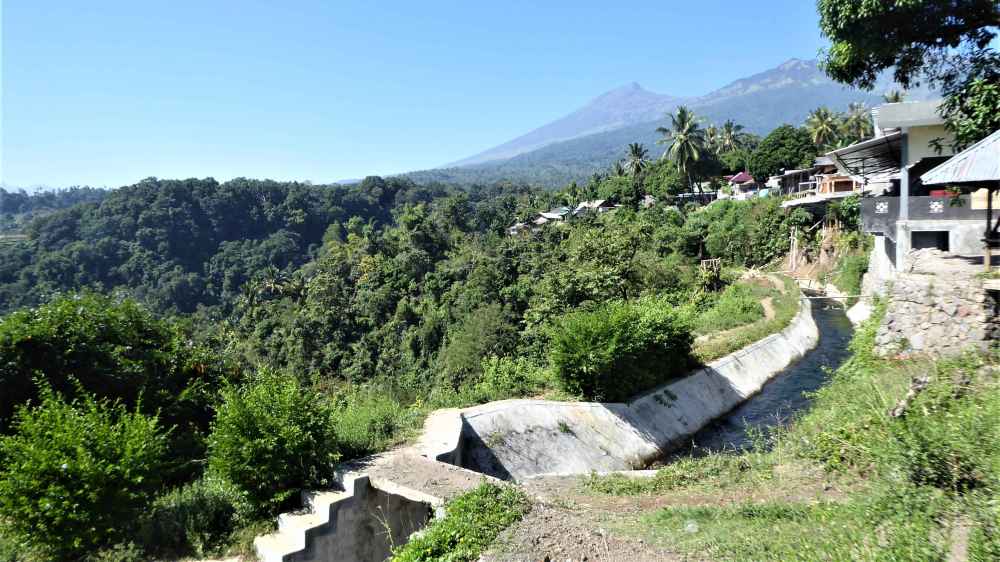
Hans would arrange transport for us from Sembalun-Lawang to Senaru at the ‘standard’ rate (650 thRupi). It is hard to understand why this route is so expensive, as we later added transport all the way to Kuta, on the other side of Lombok island, onto the itinirary, for just 350 thRupi extra. He also arranged cooked food portions (back to that later), and gave us alot of advice on the trek: where to camp, where to get water, walking times, how to do the summit, etc… He was going to help us with camping and walking equipment for our American friends who had none, but we found a place ourselves quite easily, just a few 100m up the main road from Hallo Trekker, on the right (likely the only rental place in Senaru). The equipment was basic (tent, sleeping bags and mats, gas cooker, walking poles and jacket), and in moderate condition, but affordable.
We inquired at the Park Office, only to confirm that independant trekking is indeed prohibited on the Rinjani, no matter which side you start from. This was probably not a smart move on our part as the park officer recognised us at the registration office on the first day of our trek (more on that, later!). This, however, would not deter us, and we proceeded with our preparations throughout the day.
We ended off the day with a pretty walk to 2 close-by waterfalls (Tiu Kelep being the most popular). They are accessible by many trails (see Maps.me or Google.maps), the one which doesn’t go through the ticket office, being the most scenic (along a canal, with a beautiful view on the rice fields sculpting the contours of the valley).
We did go through the ticket office going in, just because it seemed right, but were disappointed to see all the rubbish lining the river, which made us wonder where all this ‘conservation money’ is going. This would be a constant observation throughout our time on and around the Rinjani: a beautiful area with no infrastructure for waste-management, mis-managed and overrun by environmentally-unconscious tourism, an ecological nightmare. We watched the sunset eating ice-creams, stopped to chat with locals in front of the village mosque (we were surprised that they mostly just hang around outside during the call to prayer!), and enjoyed dinner at a restaurant overlooking the valley, sharing information with a group of foreigners who were embarking on the trek the next day.

We had a well-deserved lie-in the next day, as we waited for our American friends to arrive. The afternoon was spent on final preparations with them: fetching the rental equipment, shopping for food (our cooked portions for lunch would be complemented by pasta or noodles for dinner, and tea, bread, honey, apples and chocolate biscuits for breakfast or snacks), and packing our bags. We also stocked up on all-important water: 2 x 1,5L bottles per person for 3 days (taking into account that there is only one reliable refill-point halfway through the trek), at the camp by the crater-lake on the second day, and this water should be treated).
We were finally ready! After a restless night, we woke up before sunrise to get a head-start on the heat, the crowds, and the grueling day ahead. We were ready, but nothing else was: no breakfast and no cooked food portions! We knew the staff had been up late into the night preparing them, so went to look in the kitchen, only to discover it had been ransacked by the monkeys! Someone had mindlessly left the door open. This was a disaster: we could not leave without food, and shops only opened much later in the day, potentially adding an extra night and day to our tight itinirary. We called Hans, hardly believing he could pull through at such short notice. But he did! Within 30 minutes, we had banana pancakes in our bellies, new food portions in our bags (we still have no idea where he got them from), and were being moto-taxied to the trailhead, 1 by 1 with our packs on our backs. All was not lost! We were at the park registration office by 8 AM.

Here, 2 things were confirmed to us: as of today, 1st of July 2017, the entrance fee was doubling from 150 thRupi to 300 thRupi (rougly 20 euros), and it is indeed prohibited to trek the Rinjani without a guide and porter. And this would be repeated to us over and over again by guides and porters alike, throughout the trek, and again at the exit registration office in Sembalun Lawang. But we weren’t going anywhere. We would not have objected to taking a guide, but the problem is that guides on the Rinjani insist on having a porter. And the porters on the Rinjani are shamefully exploited: for a stipend they run up and down the mountain, in flip-flops, several times a week, carrying 2 bamboo baskets weighing up to 20 kgs each, hanging off either side of a pole balancing on their shoulders, leaving them with only one free hand to lift their scrawny bodies over huge steps, rocks and tree trunks. They may be superhuman, but a backpack and proper walking shoes never killed anyone! Plus, we enjoy independant trekking, and on such a crowded trail, there is no need for a guide.
After much huffing and puffing, warnings, paperwork and backpack inspections, the park officer eventually let us through. We were given a bag for our rubbish, that they would be collecting on the other side, which we found was a good initiative.

We had a long day ahead: a very steep +2000 m gradient, with full packs on, and it wasn’t getting any cooler. We traipsed up the shadded trail, only taking a decent break for lunch, at Pos II. There, we watched the monkeys intrepidly attempting to steal our food and get into our packs. We chatted with the locals who shared some of Indonesia’s famous coffee with us.

One of them had a serious burn all across his face from an accident with a camp fire. His friends didn’t seem worried: they had wrapped him up in fabric, and weren’t in any particular rush to get down. We felt sorry for the guy, it looked like he needed to get to a hospital fast, or be scared for life. We offered him some moisturizing face cream, kicking ourselves for having forgotten our burn cream.
It was a long week-end so the mountain was crowded with locals. They were all doing the trek independantly, only paying a small percentage of the ‘foreigner’ entrance fee. This fee is fair when you consider all the conservation work needed in such a huge area, but not when you consider that, as locals, the majority of hikers are paying little, and getting no grief about trekking independantly or leaving their rubbish on the mountain, and thus, have little incentive for changing their ways. Due to this leniancy, mis-management, and even corruption, the mountain is full of rubbish. The locals, and porters of tour groups, partially burn their rubbish on the mountain, leaving the rest to be spread by the wind and monkeys.
It was a long, hard walk up, the trail steep and gravely, and the views not very rewarding. When not interrogated about the absence of our guide and porter, we were encouraged by the locals “Hati Hati!”, “Slowly, Slowly!”, “Spirit, Spirit!”. We kept a steady pace, Brook and TJ usually waiting for us during their smoke breaks. We were in awe at the capabilities of their lungs!
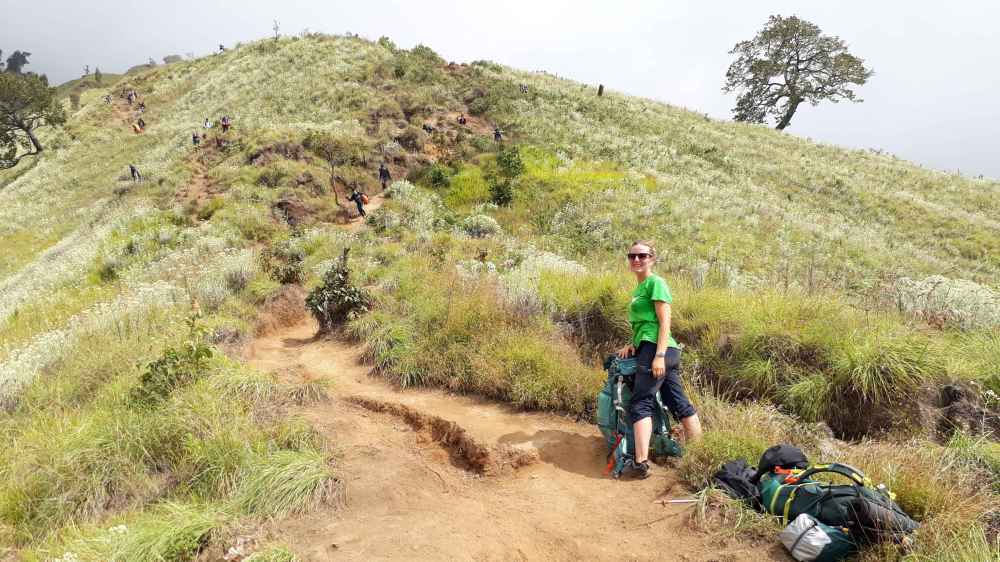
We finally made it to the Rim Camp, an hour before sunset. We had just enough time to find a spot (there aren’t many due to the steep slope, which is a problem when trekking independantly), clear the inevitable rubbish, set-up camp, collect fire-wood and reward ourselves with a hot tea. We also got our first glimpse inside the Rinjani crater. It got chilly as soon as the sun started to set, but the panorama over the clouds was well worth all of today’s suffering.
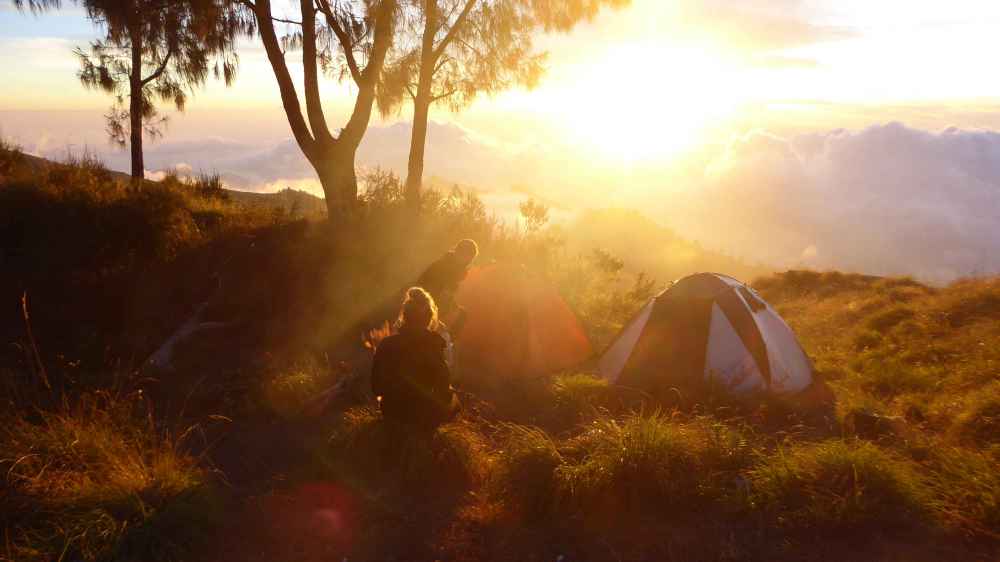
The sky was painted orange and purple, and we could spot other volcanos dotting the horizon in the distance. Renaud and TJ shared a ‘guy moment’, while us ladies got the fire going!
We nurtured it until the wood ran out, sharing dinner and lively conversation, getting to know more about our unorthodox trekking companions. Our curiosity was sparked by music echoing from down in the crater: a wild party was going on in this unlikely setting!
The next day we were in for more suffering, plus dismal weather.
It started off early, with a spectacular clear view into the crater and its aptly-named ‘Child of the Sea’ lake (Segara Anak), the biggest in Indonesia. It was coloured yellow in places, as if from some kind of mineral or chemical deposit. We could see Rinjani’s baby volcano, Barujari, born from a huge eruption in 1995, and peer right down into its own, perfectly conical, steaming, crater.

We enjoyed this view as we scrambled down the -600 m gradient to the lake.
The over-crowding and rubbish situation here was the worst, which was disappointing. This, and the heavy mist, prevented us from enjoying the shores of the lake, its famous hot-water springs (which are very small). Our priority was to collect water and use some more to pre-cook pasta for tonight, and noodles for lunch. This took ages – not the most enjoyable part of the trek!


Nor was the +650 m climb back up the rim, to the Rinjani Base Camp. We were in the clouds the whole way, only getting a brief respite on arrival, while setting up camp (a good a time as any!). For this reason too, the sunset was less spectacular than the previous evening’s. There is no wood to be found at this campsite, so we went to bed right after dinner.
It was a cold night, and an even colder morning! Renaud and I got up at 2 AM to do the summit, while our sleepy companions guarded our tent! It was repeated that theft is a problem for independant trekkers (but by not-so-independant guides who would have liked to sell us a tour!). Anyway it’s important to know that there is no hiding place easily-accessible in the dark, so an independant trekker doing the summit this way, likely has to leave his/her stuff behind, out in the open.
It took us just under 3 hours to get to the top. We both made it by sheer mental power, controlled breathing and pacing of our efforts. The +1000 m slope is steep and very gravelly, so it’s litteraly 2 steps up, 1 step down, unless you walk slower, wedging your feet in well at every step (like walking in snow), conserving energy in the process. Alot of people seemed to be suffering from the cold too, especially during breaks or on the summit: be prepared for the bitter wind – gloves, bennies, scarves, leggings and a good jacket are not an option! We made good time: starting almost last – the snake of headlamps sparkling in the distance above us – we overtook group by group by group, hardly ever stopping for fear of breaking the ‘mental mojo’! Sunrise on the summit was spectacular, the sky was partially clear and we could see all the way around the Rinjani and Lombok, across to it’s neighbouring islands and volcanoes.

It was quite a special moment after all the mental and physical strain.
Doing sunrise on the summit here is almost inevitable: the daytime heat, dust and continuous flow of trekkers walking down as you are walking up, would make the experience quite challenging if done otherwise.
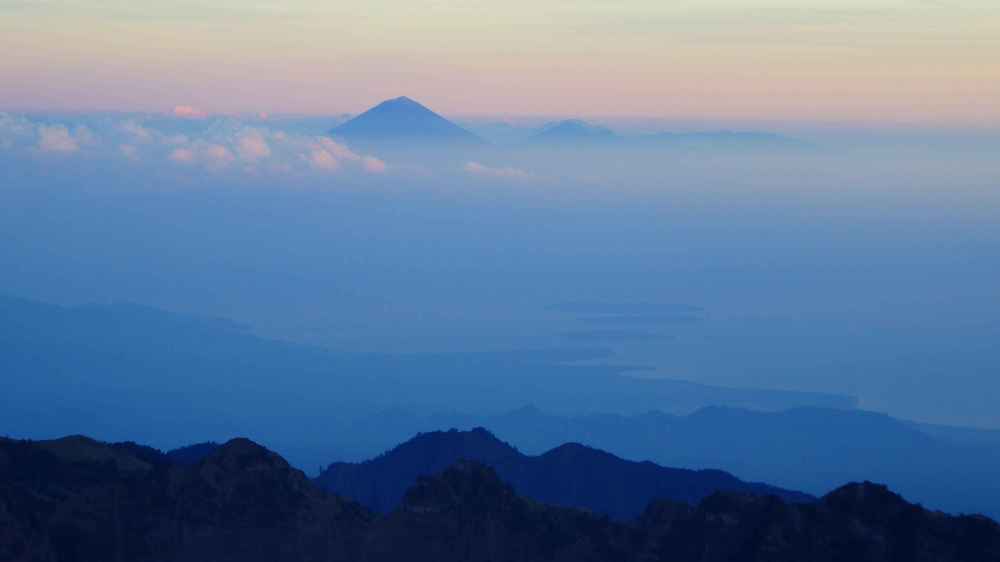
We didn’t hang around long after sunset: our friends would be waiting and we were aiming to travel to our next destination on the other side of Lombok island, that evening. We had a huge -2800 m descent between us and our pick-up in Semalun Lawang! The first part, getting down the summit, was actually quite fun. We got to appreciate the breathtaking views on either side of us, as we descended the shear ridge we had walked up a few hours ago in the dark.

It felt like skiing on the the Moon, as we made gigantic, weightless strides in the deep, crunchy, rolling, gravel.

We hardly took a break when we arrived at camp: we were packed up and ready to go within an hour of arriving.

Brook and TJ were in top form, well ahead of us most of the way down the dry, dusty path. I was starting to feel intense pain in the tips of my toes and knees, mainly due to my uncut toe-nails which prevented me from gaining speed. Over halfway down, we got speaking to a girl on her way up at a rest stop, and she miraculously had a pair of nail-clippers that changed my life in that moment! I was free to run and jump again, but now my knees hurt! With a few more hours to spare, I would’ve made it down, but we were in a rush, so at the first possible location, we rented a moto-taxi to wisk me off the mountain, all the way to the registration office in Sembalun Lawang. The driver was a real pro, navigating the steep dirt track and deep rivers effortlessly, with my weight, and that of my pack, hanging onto him for dear life! He was not a pro however in the ‘communication’ department, as he flirted with me shamelessly from start to finish.
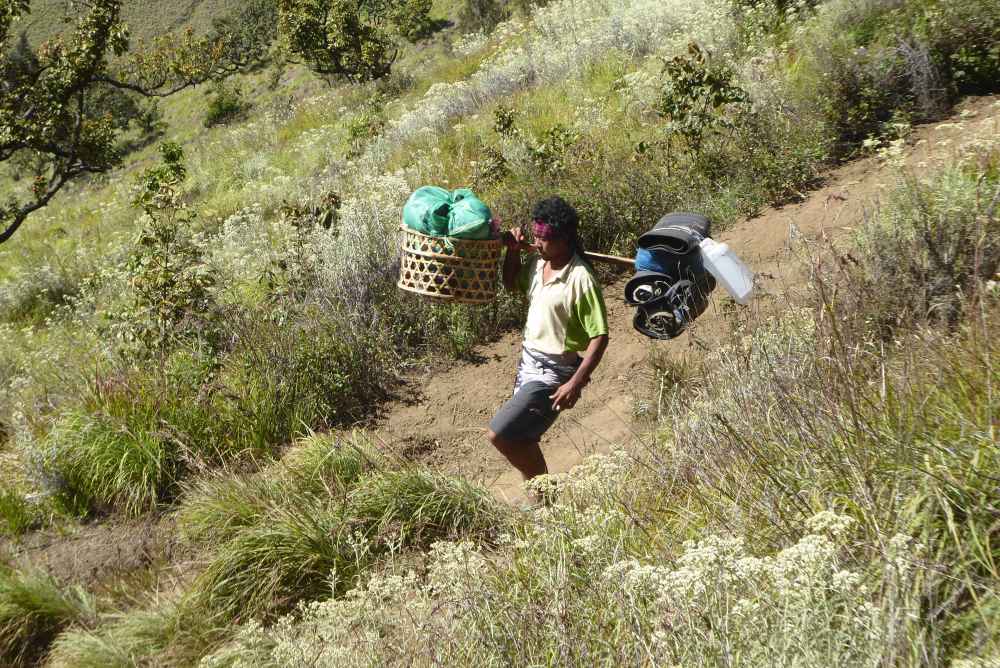
I got to the registration office before the others, time enough to start the administrative proceedings on this side of the mountain. A few phone calls, formulas, and a vow never to breath a word of the possibility of independant trekking on the Rinjani to anyone, later, and we were merrily waiting for our transport out of there (destination Kuta, Lombok). Jokes aside, they don’t make it easy, and if you are not prepared for alot of hasstle, do not attempt to do this trek without a guide and porter!
The Rinjani was our 3rd volcano (Renaud’s 4th), but none of the others matched it’s surreal topography and picture-perfect views. We loved the challenge but were immensely bothered by the administrative obstacles to independant trekking, and by the sad environmental state of the park. It is nevertheless a more than worth-while effort, and there may still be hope: discussing with the park officers, programs are being put in place to correct budget and maintenance issues, better control the influx of hikers, and their rubbish, and educate them on responsable hiking.







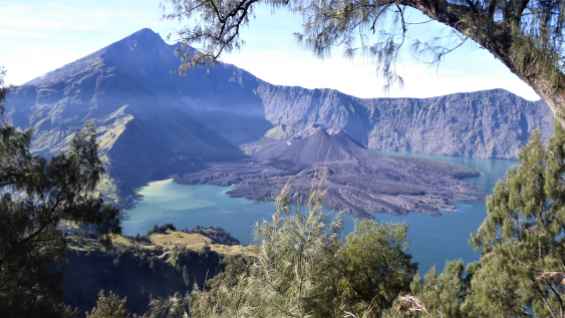




Great story – in awe of your adventures regards Monica and Roger
LikeLike
Thanks Mon & Rog! Nice to know a few ppl actually read it 😉
Did you already have a wordpress account?
LikeLike